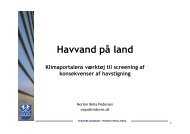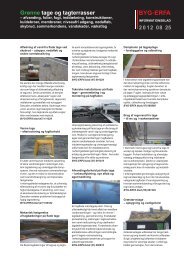Mapping climate change - barriers and opportunities for action
Mapping climate change - barriers and opportunities for action
Mapping climate change - barriers and opportunities for action
You also want an ePaper? Increase the reach of your titles
YUMPU automatically turns print PDFs into web optimized ePapers that Google loves.
Climate <strong>change</strong> adaptation is carried out with assistance from large engineering firms, which are<br />
also widely used by local governments <strong>and</strong> other authorities. As the same mindset has been applied<br />
in risk perceptions, methods <strong>and</strong> solutions, collaborative ef<strong>for</strong>ts with municipalities <strong>and</strong> other<br />
players have been good. However, long-term planning of <strong>climate</strong> <strong>change</strong> poses special challenges<br />
which only few municipalities relate to in practice in their work on <strong>climate</strong> <strong>change</strong> adaptation.<br />
Recent years have seen a huge increase in the availability of tools due especially to work taking<br />
place within the framework of the Danish Ministry of the Environment's portal on <strong>climate</strong> <strong>change</strong><br />
adaptation at www.klimatilpasning.dk. With regard to long-term planning, an especially useful tool,<br />
Sea Water on L<strong>and</strong> (Havv<strong>and</strong> på L<strong>and</strong>), makes it possible to plan <strong>for</strong> any surprises relative to<br />
current <strong>climate</strong> <strong>for</strong>ecasts.<br />
The blue-spot analysis is another interesting tool developed by the Danish Road Directorate.<br />
Regulation<br />
Planning by Rail Net Denmark is generally based on a series of st<strong>and</strong>ards. In future years, Rail Net<br />
Denmark will carry out a revision of the drainage st<strong>and</strong>ard which determines the dimensioning of<br />
drainage systems <strong>for</strong> surface water etc.<br />
Summary<br />
Greater rainfall amounts <strong>and</strong> more powerful storms may have different effects on the rail network.<br />
Rail Net Denmark is preparing to cope with increased precipitation <strong>and</strong> stronger winds by analysing<br />
road-related events, establishing warning systems, revising existing technical railway st<strong>and</strong>ards, <strong>and</strong><br />
by analysing the need to incorporate <strong>climate</strong> <strong>change</strong> adaptation in the planning of new rail<br />
installations. Finally, Rail Net Denmark is also working on managing <strong>climate</strong> <strong>change</strong> impacts on the<br />
basis of per<strong>for</strong>mance requirements. This involves preparing an <strong>action</strong> plan <strong>for</strong> <strong>climate</strong> <strong>change</strong><br />
adaptation on the basis of the Ministry of Transport's <strong>climate</strong> <strong>change</strong> adaptation strategy. This<br />
<strong>action</strong> plan is to contain targets <strong>and</strong> a milestone plan as well as a "declaration of services"<br />
concerning the availability of the railway infrastructure.<br />
43

















